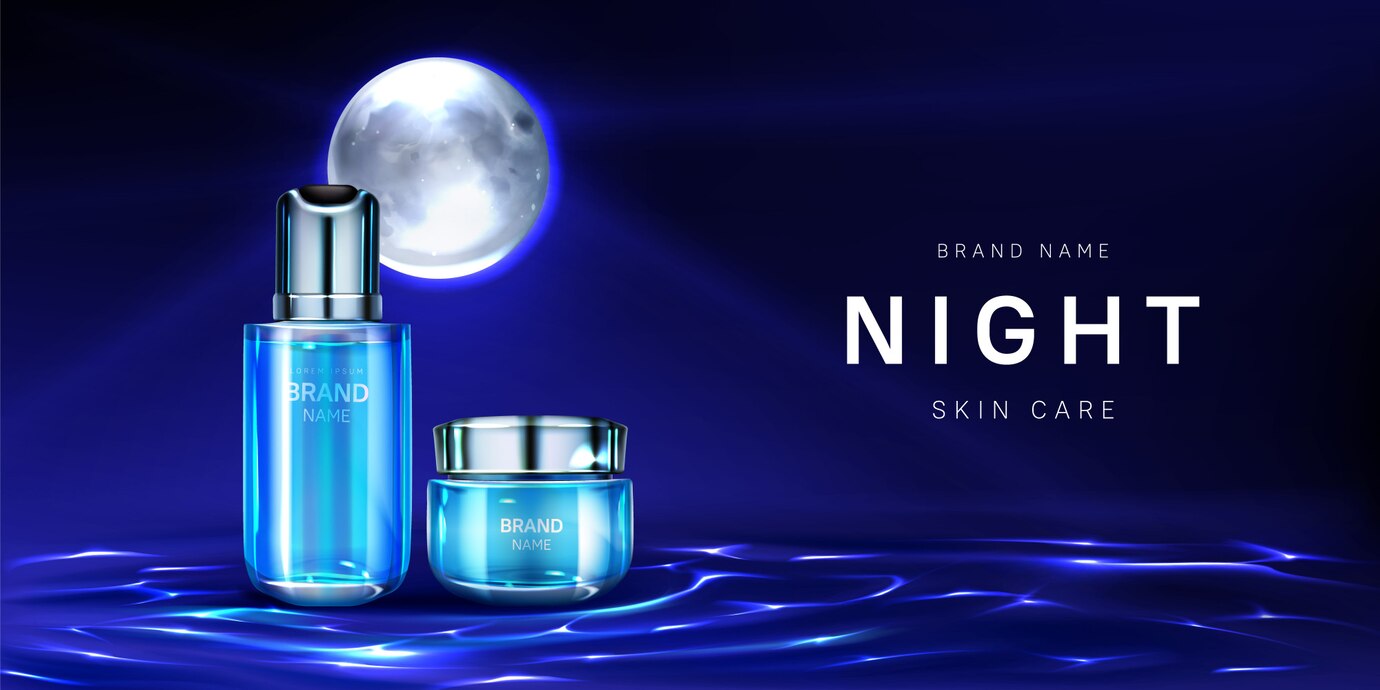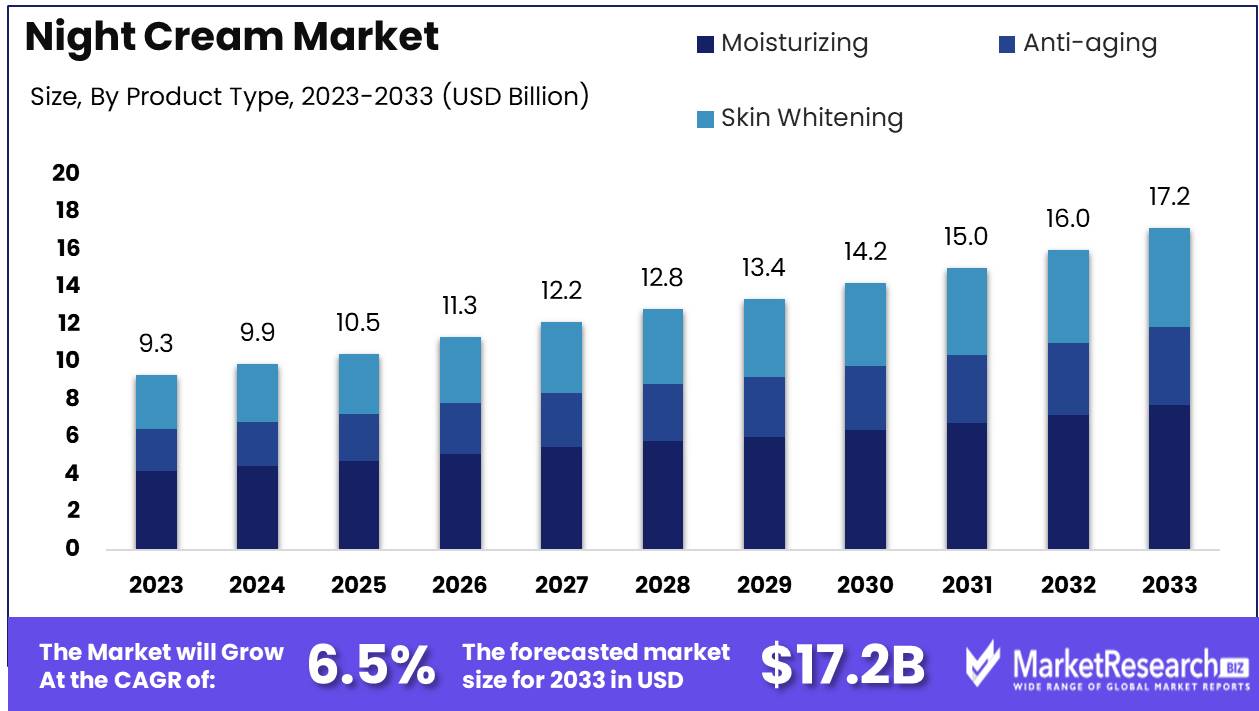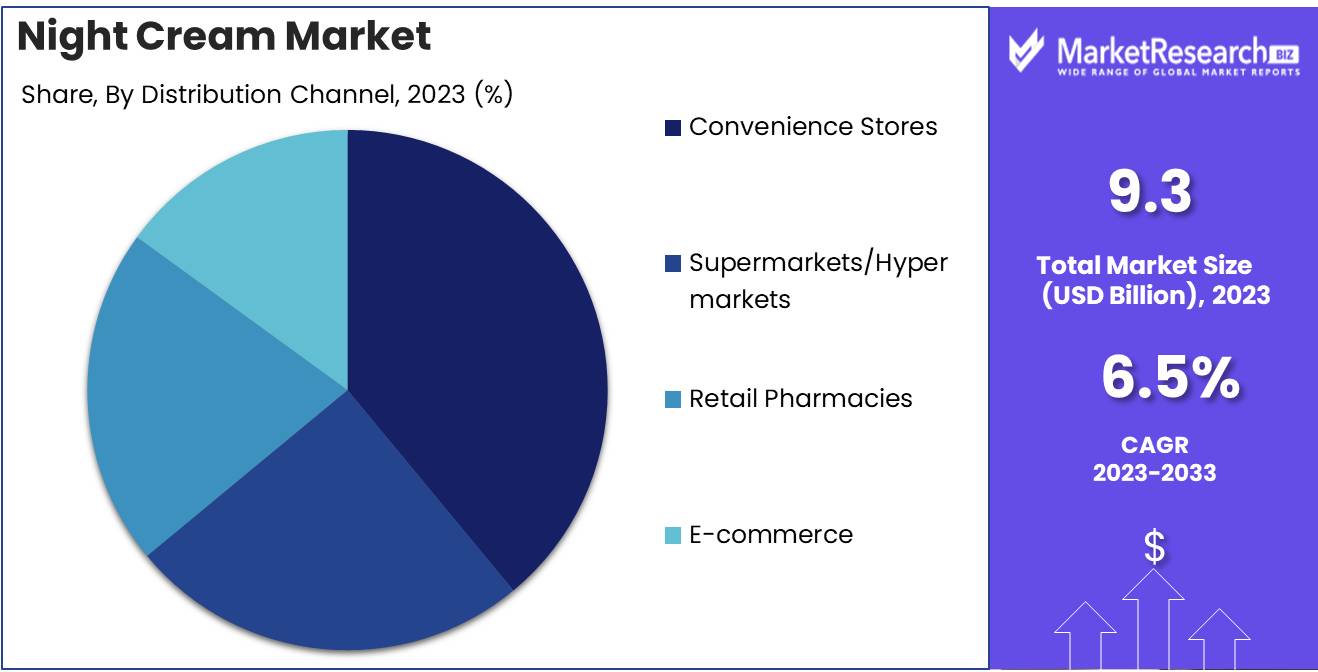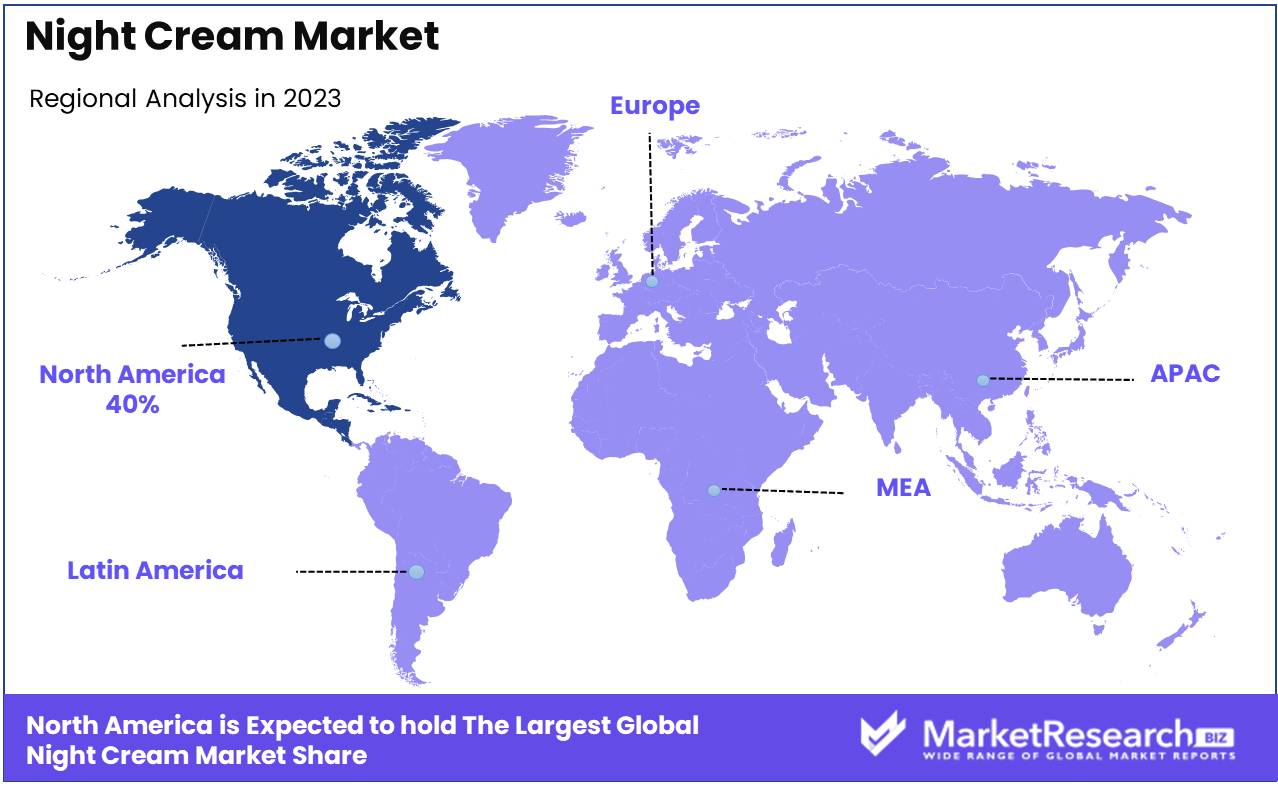
Night Cream Market By Product Type (Moisturizing, Anti-aging, Skin Whitening), By Skin Type (Dry Skin, Oily Skin, Combination Skin, All Skin Types, Others), By Distribution Channel (Convenience Stores, Supermarkets/Hypermarkets, Retail Pharmacies, Ecommerce), By Region And Companies - Industry Segment Outlook, Market Assessment, Competition Scenario, Trends, And Forecast 2024-2033
-
49893
-
August 2024
-
300
-
-
This report was compiled by Shreyas Rokade Shreyas Rokade is a seasoned Research Analyst with CMFE, bringing extensive expertise in market research and consulting, with a strong background in Chemical Engineering. Correspondence Team Lead-CMFE Linkedin | Detailed Market research Methodology Our methodology involves a mix of primary research, including interviews with leading mental health experts, and secondary research from reputable medical journals and databases. View Detailed Methodology Page
-
Quick Navigation
Report Overview
The Night Cream Market was valued at USD 9.3 billion in 2023. It is expected to reach USD 17.2 billion by 2033, with a CAGR of 6.5% during the forecast period from 2024 to 2033.
The Night Cream Market encompasses the sector dedicated to skincare products formulated for application before bedtime. These creams are designed to nourish, hydrate, and repair the skin overnight, leveraging active ingredients such as retinoids, peptides, and hyaluronic acid. The market is characterized by a diverse range of offerings, including anti-aging, moisturizing, and restorative formulations. Growth in this market is driven by increasing consumer awareness of skin health, rising demand for premium and personalized skincare solutions, and advancements in dermatological research.

The Night Cream market is experiencing notable growth, driven by increasing consumer awareness of skincare and the rising demand for anti-aging products. As consumers become more knowledgeable about the importance of maintaining skin health and addressing signs of aging, the market for night creams has expanded. This heightened awareness is coupled with a strong preference for products that offer advanced anti-aging benefits, fueling market growth.
Additionally, the competitive landscape within the night cream segment is intensifying, with numerous brands vying for market share. This high level of competition is propelling innovation and leading to the introduction of new formulations and technologies.
However, the market also faces challenges. Adverse reactions to skincare products remain a significant concern, potentially impacting consumer trust and product adoption. Furthermore, emerging trends such as the increasing preference for natural and organic ingredients are shaping market dynamics. Consumers are increasingly seeking products that align with these trends, which is prompting brands to adapt their offerings accordingly. In summary, while the Night Cream market is poised for growth, stakeholders must navigate challenges related to adverse reactions and stay attuned to evolving consumer preferences to maintain a competitive edge.
Key Takeaways
- Market Growth: The Night Cream Market was valued at USD 9.3 billion in 2023. It is expected to reach USD 17.2 billion by 2033, with a CAGR of 6.5% during the forecast period from 2024 to 2033.
- By Product Type: Moisturizing night creams dominated the Night Cream Market.
- By Skin Type: Dry Skin led the Night Cream Market with targeted formulations.
- By Distribution Channel: Convenience Stores dominated the Night Cream Distribution Channel segment.
- Regional Dominance: North America leads the global night cream market with a 40% largest share.
- Growth Opportunity: The global Night Cream market is poised for growth driven by the increasing demand for natural and organic ingredients and the continued expansion of e-commerce platforms.
Driving factors
Increasing Demand for Advanced Skincare Solutions Targeting Specific Skin Concerns
The surge in demand for advanced skincare solutions that address specific skin concerns has significantly propelled the growth of the Night Cream Market. Consumers increasingly seek products that offer targeted treatments for issues such as dehydration, hyperpigmentation, and uneven skin tone. Night creams, designed to be applied before bedtime, are particularly effective in delivering concentrated active ingredients that work overnight to address these concerns. This shift towards specialized skincare has been driven by advancements in dermatological research and the availability of innovative ingredients, such as peptides, hyaluronic acid, and retinoids. The market has witnessed a corresponding increase in product offerings that cater to these specific needs, further fueling growth.
Rising Awareness of the Skin's Natural Repair Processes During Sleep
The growing awareness of the skin's natural repair processes during sleep has also contributed to the expanding Night Cream Market. Research has highlighted that the skin undergoes significant repair and regeneration while individuals sleep. This understanding has led to an increased emphasis on using night creams to enhance these natural processes. Night creams are formulated with ingredients that support the skin's restorative functions, such as antioxidants, vitamins, and repair agents, aligning with consumers' desire for products that optimize their skin’s health while they rest. As awareness of these processes continues to rise, more consumers are adopting night creams as a crucial part of their nighttime skincare routine.
Growing Popularity of Anti-Aging Skincare Products
The escalating popularity of anti-aging skincare products is a major driver of the Night Cream Market's growth. Anti-aging concerns are prevalent among a broad demographic, with consumers seeking products that can mitigate signs of aging, such as wrinkles, fine lines, and loss of elasticity. Night creams, which often contain potent anti-aging ingredients like retinol, collagen boosters, and hyaluronic acid, are increasingly being favored for their ability to provide intensive treatment during the night. The rising demand for such products is a direct response to the growing focus on maintaining youthful skin and the effectiveness of night creams in delivering long-term anti-aging benefits.
Restraining Factors
High Cost of Products
The high cost of night creams is a significant restraining factor impacting the growth of the Night Cream Market. Premium formulations and high-quality ingredients often drive up the price of these products, which can limit consumer access and reduce market penetration. According to market data, the average price of high-end night creams ranges from $50 to $200, which can be a barrier for price-sensitive consumers.
The elevated cost is particularly impactful in emerging markets where disposable incomes are lower. Consumers in these regions may prioritize essential products over luxury items like high-priced night creams. Consequently, this restricts the market's potential growth in these areas. Additionally, even in developed markets, the high cost can deter frequent purchases and reduce overall market volume.
To mitigate this issue, some brands have introduced more affordable lines or smaller packaging options to cater to a broader audience. However, the overall high cost remains a notable obstacle to broader market expansion.
Ineffective Supply Chain Management
Ineffective supply chain management further exacerbates the growth challenges in the Night Cream Market. Disruptions in the supply chain can lead to inconsistent product availability, increased costs, and delayed product launches. For instance, issues such as raw material shortages, transportation delays, and logistical inefficiencies can lead to stockouts and affect the overall market dynamics.
According to industry reports, supply chain disruptions have caused delays in product availability and have contributed to increased production costs by approximately 15% in recent years. This inefficiency can deter potential market entrants and existing players from expanding their operations or investing in new market segments.
Additionally, poor supply chain management can lead to inconsistencies in product quality, which can impact consumer trust and brand reputation. As a result, companies may face increased challenges in maintaining a stable customer base and achieving sustainable growth.
By Product Type Analysis
In 2023, Moisturizing night creams dominated the Night Cream Market.
In 2023, The Moisturizing segment held a dominant market position in the Night Cream Market. This segment's prominence is attributed to the increasing consumer preference for products that offer intense hydration and nourishment during sleep. Moisturizing night creams are formulated to restore the skin’s moisture balance, counteracting the dryness caused by environmental factors and aging. The segment benefits from widespread consumer awareness about skin hydration's importance for maintaining a healthy complexion. The efficacy of moisturizing ingredients like hyaluronic acid, glycerin, and ceramides has driven their preference, contributing to this segment’s substantial market share.
In contrast, the Anti-aging segment, while growing, did not surpass the moisturizing segment in market dominance. Anti-aging night creams are favored for their ability to reduce fine lines, wrinkles, and other signs of aging, leveraging ingredients like retinol and peptides. Similarly, the Skin Whitening segment appeals to consumers seeking to even out skin tone and reduce hyperpigmentation with components such as vitamin C and niacinamide. Despite its niche focus, the skin whitening segment remains a significant player due to regional preferences and ongoing skin-lightening trends.
By Skin Type Analysis
In 2023, Dry Skin led the Night Cream Market with targeted formulations.
In 2023, The Dry Skin segment held a dominant market position in the Night Cream Market. This segment’s strong performance can be attributed to the increasing consumer awareness regarding the benefits of night creams specifically formulated for dry skin. Products targeting dry skin often contain hydrating and nourishing ingredients such as hyaluronic acid, ceramides, and glycerin, which cater to consumers seeking effective solutions for moisture retention and skin barrier repair. The rise in environmental factors contributing to skin dryness, such as pollution and climate change, further enhances the demand for these specialized formulations.
In the Night Cream Market, the Oily Skin segment also exhibited notable performance, driven by an increasing number of consumers seeking non-comedogenic and lightweight formulations. Night creams for oily skin are often designed to balance sebum production and provide hydration without exacerbating oiliness. The Combination Skin segment saw steady growth due to the demand for versatile products that cater to multiple skin concerns simultaneously. The All Skin Types segment benefited from its broad applicability, offering convenience to consumers looking for universal solutions. Lastly, the Others category, encompassing specialized needs and niche formulations, contributed to the market with tailored solutions addressing unique skin requirements. Each segment's performance reflects the diverse consumer preferences and the market's response to varying skincare needs.
By Distribution Channel Analysis
In 2023, Convenience Stores dominated the Night Cream Distribution Channel segment.
In 2023, Convenience Stores held a dominant market position in the Distribution Channel segment of the Night Cream Market. Convenience stores have increasingly become preferred retail points for consumers seeking quick and easy access to night creams due to their strategic locations and extended operating hours. This convenience factor has significantly contributed to their leading position within the market.
Supermarkets/Hypermarkets followed closely, benefiting from their broad product range and ability to offer night creams alongside other beauty and personal care products. Retail Pharmacies have also maintained a substantial share, leveraging their specialized knowledge and consumer trust in health and skincare products.
Lastly, E-commerce platforms have experienced notable growth, driven by their convenience, extensive product selections, and the rising trend of online shopping. Despite this, convenience stores' accessibility and immediacy solidify their top position in the segment, highlighting their critical role in the distribution of night creams.

Key Market Segments
By Product Type
- Moisturizing
- Anti-aging
- Skin Whitening
By Skin Type
- Dry Skin
- Oily Skin
- Combination Skin
- All Skin Types
- Others
By Distribution Channel
- Convenience Stores
- Supermarkets/Hypermarkets
- Retail Pharmacies
- E-commerce
Growth Opportunity
Rising Demand for Natural and Organic Ingredients
The global Night Cream market presents significant opportunities, particularly driven by the rising consumer preference for natural and organic ingredients. Consumers are increasingly seeking skincare products formulated with natural, organic components due to their perceived safety and efficacy. This shift is not only aligned with the broader wellness trend but also reflects growing environmental and health consciousness among consumers. Brands that leverage natural and organic ingredients can differentiate themselves in a crowded market, appealing to the health-conscious segment and potentially commanding premium pricing. This trend is expected to drive innovation and product development, as companies strive to meet the evolving demands of their customer base.
Expansion of E-commerce Platforms
The expansion of e-commerce platforms is another key factor contributing to the opportunities within the Night Cream market. The digital transformation has made it easier for consumers to access a wider range of products and brands, including niche and premium night creams. E-commerce platforms provide a valuable channel for companies to reach global markets and engage with customers through targeted marketing and personalized experiences.
Additionally, the convenience and accessibility of online shopping enhance consumer purchase behavior, leading to increased sales and brand visibility. As e-commerce continues to grow, it is anticipated that online sales of night creams will expand, offering substantial growth opportunities for companies that effectively capitalize on digital platforms.
Latest Trends
Emphasis on Sustainability in Night Cream Formulations
The Night Cream Market is witnessing a significant shift towards sustainability. Consumers and companies alike are increasingly prioritizing eco-friendly practices. Brands are focusing on using natural and organic ingredients, minimizing environmental impact through sustainable sourcing, and reducing plastic waste with recyclable or biodegradable packaging. This trend aligns with the broader movement towards greener beauty products, reflecting a growing consumer preference for brands that demonstrate environmental responsibility.
Heightened Consumer Awareness and Demand for Transparency
Consumer awareness in the night cream segment has markedly increased. Shoppers are now more informed about the ingredients and efficacy of skincare products, driven by a surge in digital information and social media influence. This heightened awareness has led to a demand for transparency from brands regarding ingredient sourcing, product benefits, and potential allergens. Companies are responding by providing detailed information on their product labels and through educational marketing efforts. The trend signifies a shift towards a more informed consumer base that values authenticity and seeks products that align with their personal values and skincare needs.
Regional Analysis
North America leads the global night cream market with a 40% largest share.
North America: The North American night cream market demonstrates a dominant position due to the high demand for premium and innovative skincare products. In 2023, the market share for North America was approximately 40%, driven by a robust consumer base that prioritizes advanced skincare solutions and personal grooming. The United States and Canada are major contributors to this growth, fueled by increased disposable incomes and a strong preference for high-quality beauty products. The region is characterized by the presence of several leading market players and a high level of product innovation, including the incorporation of advanced ingredients and technology.
Europe: Europe holds a significant share of the global night cream market, accounting for roughly 30% in 2023. The market is propelled by a growing awareness of skincare and the demand for natural and organic products. Major markets such as Germany, France, and the UK are key players, reflecting a strong consumer inclination towards sustainable and eco-friendly products.
Asia Pacific: Asia Pacific exhibits rapid growth, with a market share of around 20% in 2023. The expanding middle class, rising disposable incomes, and increasing beauty consciousness in countries like China and India are driving this growth. The region is experiencing a surge in demand for both affordable and luxury night creams.
Middle East & Africa: This region represents a smaller segment, holding about 5% of the market. However, there is a growing interest in skin care products, influenced by increasing urbanization and a rising standard of living.
Latin America: Latin America contributes to approximately 5% of the global night cream market. The market is gradually expanding, driven by a burgeoning middle class and increasing interest in beauty and personal care.

Key Regions and Countries
North America
- The US
- Canada
- Rest of North America
Europe
- Germany
- France
- The UK
- Spain
- Netherlands
- Russia
- Italy
- Rest of Europe
Asia-Pacific
- China
- Japan
- Singapore
- Thailand
- South Korea
- Vietnam
- India
- New Zealand
- Rest of Asia Pacific
Latin America
- Mexico
- Brazil
- Rest of Latin America
Middle East & Africa
- Saudi Arabia
- South Africa
- UAE
- Rest of the Middle East & Africa
Key Players Analysis
The global Night Cream Market remains highly competitive, with several prominent players driving innovation and market share. L’Oréal S.A. continues to lead with its extensive portfolio, leveraging its R&D capabilities to introduce advanced formulations that cater to diverse skin needs. Similarly, The Estée Lauder Companies Inc. and Shiseido Co., Ltd. are notable for their premium offerings, focusing on luxury and efficacy to capture high-end market segments.
The Procter & Gamble (P&G) Company and Unilever Plc dominate with their extensive distribution networks and well-established brands, such as Olay and Pond’s, making significant inroads into mass-market segments. Guerlain and Clinique Laboratories uphold strong positions in the luxury segment by offering high-quality, innovative products.
Beiersdorf AG (Nivea) and Himalaya Global Holdings provide robust competition with their value-for-money propositions and natural ingredient-based formulations. VLCC Health Care Limited and Elizabeth Arden also maintain a market presence through their specialized formulations and targeted skincare solutions.
Emerging players like Solstice Holding and Revlon, Inc. bring new perspectives to the market with niche products and unique selling propositions. Overall, the market is characterized by a blend of established giants and dynamic newcomers, each contributing to a diverse and evolving landscape in the night cream sector.
Market Key Players
- Groupe Clarins
- The Procter & Gamble (P&G) Company
- L’Oréal S.A.
- Unilever Plc
- Shiseido Co., Ltd.
- Beiersdorf AG and Guerlain
- Clinique Laboratories
- VLCC Health Care Limited
- The Estée Lauder Companies Inc.
- Revlon, Inc.
- Solstice Holding
- Estee Lauder Companies
- Procter and Gamble
- Himalaya Global Holdings
- Elizabeth Arden
- Clarins
- Nivea
- Lancome
- Avon
Recent Development
- In May 2024, Procter & Gamble announced a new initiative to make their night cream production more sustainable. This includes reducing plastic use and incorporating eco-friendly packaging materials in their night cream line.
- In March 2024, Estée Lauder introduced a new anti-aging night cream featuring a novel peptide complex designed to enhance skin regeneration overnight. This launch is part of their strategy to strengthen their position in the high-end skincare market.
- In January 2024, L'Oréal acquired Skin Tech, a company specializing in advanced night cream formulations. This acquisition aims to bolster L'Oréal's portfolio in the premium skincare segment.
Report Scope
Report Features Description Market Value (2023) USD 9.3 Billion Forecast Revenue (2033) USD 17.2 Billion CAGR (2024-2032) 6.5% Base Year for Estimation 2023 Historic Period 2016-2023 Forecast Period 2024-2033 Report Coverage Revenue Forecast, Market Dynamics, COVID-19 Impact, Competitive Landscape, Recent Developments Segments Covered By Product Type (Moisturizing, Anti-aging, Skin Whitening), By Skin Type (Dry Skin, Oily Skin, Combination Skin, All Skin Types, Others), By Distribution Channel (Convenience Stores, Supermarkets/Hypermarkets, Retail Pharmacies, e-commerce) Regional Analysis North America - The US, Canada, Rest of North America, Europe - Germany, France, The UK, Spain, Italy, Russia, Netherlands, Rest of Europe, Asia-Pacific - China, Japan, South Korea, India, New Zealand, Singapore, Thailand, Vietnam, Rest of Asia Pacific, Latin America - Brazil, Mexico, Rest of Latin America, Middle East & Africa - South Africa, Saudi Arabia, UAE, Rest of Middle East & Africa Competitive Landscape Groupe Clarins, The Procter & Gamble (P&G) Company, L’Oréal S.A., Unilever Plc, Shiseido Co., Ltd., Beiersdorf AG and Guerlain, Clinique Laboratories, VLCC Health Care Limited, The Estée Lauder Companies Inc., Revlon, Inc., Solstice Holding, Estee Lauder Companies, Procter and Gamble, Himalaya Global Holdings, Elizabeth Arden, Clarins, Nivea, Lancome, Avon Customization Scope Customization for segments at the regional/country level will be provided. Moreover, additional customization can be done based on the requirements. Purchase Options We have three licenses to opt for Single User License, Multi-User License (Up to 5 Users), Corporate Use License (Unlimited User and Printable PDF) -
-
- Groupe Clarins
- The Procter & Gamble (P&G) Company
- L’Oréal S.A.
- Unilever Plc
- Shiseido Co., Ltd.
- Beiersdorf AG and Guerlain
- Clinique Laboratories
- VLCC Health Care Limited
- The Estée Lauder Companies Inc.
- Revlon, Inc.
- Solstice Holding
- Estee Lauder Companies
- Procter and Gamble
- Himalaya Global Holdings
- Elizabeth Arden
- Clarins
- Nivea
- Lancome
- Avon




